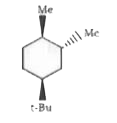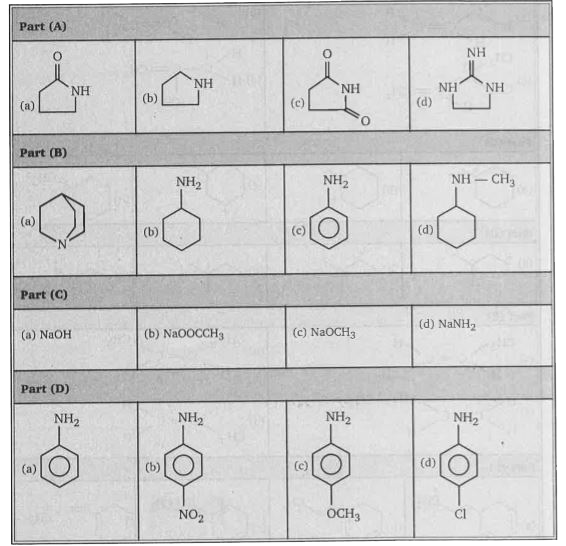The most unstable compounds fo the following are :
hydrides of C
hydrides fo Sn
hydrides of Ge
hydrides of Pb
The correct Answer is:D
To determine the most unstable hydrides among the given options (hydrides of carbon, silicon, germanium, and lead), we can analyze the stability of these hydrides based on the size of the elements involved and the nature of the bonds formed.
1. Identify the Group:
- The elements in question (carbon, silicon, germanium, tin, and lead) belong to Group 14 of the periodic table.
2. Understand the Trend in Group 14:
- As we move down Group 14 from carbon to lead, the atomic size increases. This is due to the addition of electron shells.
3. Consider the Size of Hydrogen:
- Hydrogen is relatively small compared to the Group 14 elements. When forming hydrides (compounds with hydrogen), the size difference between hydrogen and the Group 14 element affects bond stability.
4. Analyze the Hydrides:
- Hydrides of Carbon (CH₄): The bond between carbon and hydrogen is strong due to their comparable sizes.
- Hydrides of Silicon (SiH₄): Similar to carbon, the bond is stable, although slightly weaker than CH₄.
- Hydrides of Germanium (GeH₄): The bond is weaker than that of silicon due to the larger size of germanium.
- Hydrides of Tin (SnH₄): The bond is further weakened as tin is larger than germanium.
- Hydrides of Lead (PbH₄): Lead is the largest in this group, leading to the weakest bond with hydrogen.
5. Determine Stability:
- The stability of a hydride is inversely related to the bond dissociation enthalpy; the lower the enthalpy, the less stable the compound.
- Since lead has the largest atomic size, the bond between lead and hydrogen is the weakest, making PbH₄ the most unstable hydride.
6. Conclusion:
- Therefore, the most unstable hydride among the given options is the hydride of lead (PbH₄).
Final Answer:
The most unstable compound among the given options is the hydride of lead (PbH₄).
---
- The elements in question (carbon, silicon, germanium, tin, and lead) belong to Group 14 of the periodic table.
- As we move down Group 14 from carbon to lead, the atomic size increases. This is due to the addition of electron shells.
- Hydrogen is relatively small compared to the Group 14 elements. When forming hydrides (compounds with hydrogen), the size difference between hydrogen and the Group 14 element affects bond stability.
- Hydrides of Carbon (CH₄): The bond between carbon and hydrogen is strong due to their comparable sizes.
- Hydrides of Silicon (SiH₄): Similar to carbon, the bond is stable, although slightly weaker than CH₄.
- Hydrides of Germanium (GeH₄): The bond is weaker than that of silicon due to the larger size of germanium.
- Hydrides of Tin (SnH₄): The bond is further weakened as tin is larger than germanium.
- Hydrides of Lead (PbH₄): Lead is the largest in this group, leading to the weakest bond with hydrogen.
- The stability of a hydride is inversely related to the bond dissociation enthalpy; the lower the enthalpy, the less stable the compound.
- Since lead has the largest atomic size, the bond between lead and hydrogen is the weakest, making PbH₄ the most unstable hydride.
- Therefore, the most unstable hydride among the given options is the hydride of lead (PbH₄).
The most unstable compound among the given options is the hydride of lead (PbH₄).
Topper's Solved these Questions
- P-BLOCK GROUP 14 - CARBON FAMILYBOOK - CENGAGE CHEMISTRY ENGLISHCHAPTER - P-BLOCK GROUP 14 - CARBON FAMILYEXERCISE - Exercises (Assertion-Reasoning)
27 Videos
- P-BLOCK GROUP 14 - CARBON FAMILYBOOK - CENGAGE CHEMISTRY ENGLISHCHAPTER - P-BLOCK GROUP 14 - CARBON FAMILYEXERCISE - Exercises (Integer)
7 Videos
- P-BLOCK GROUP 14 - CARBON FAMILYBOOK - CENGAGE CHEMISTRY ENGLISHCHAPTER - P-BLOCK GROUP 14 - CARBON FAMILYEXERCISE - Exercises (Multiple Correct )
19 Videos
- P-BLOCK GROUP 13 - BORON FAMILYBOOK - CENGAGE CHEMISTRY ENGLISHCHAPTER - P-BLOCK GROUP 13 - BORON FAMILYEXERCISE - Exercise Archives (Subjecive)
9 Videos
- PERIODIC CLASSIFICATION OF ELEMENTS AND GENERAL INORGANIC CHEMISTRYBOOK - CENGAGE CHEMISTRY ENGLISHCHAPTER - PERIODIC CLASSIFICATION OF ELEMENTS AND GENERAL INORGANIC CHEMISTRYEXERCISE - Exercises (Archives )Subjective
4 Videos
Similar Questions
Knowledge Check
The most stable conformation of the following compound is :
 A
A B
B C
C D
D
Which of the following gases forms the most stable compound with haemoglobin as erythrocytes?
AOxygenBCarbon monoxideCNitrogenDCarbon dioxide
The most unstable molecule is
View SolutionMost covalent compound among the following
View SolutionThe most polar compound among the following is :
View SolutionIdentify the most basic compound in the following.

View SolutionWhich is more unstable of each of the following pairs, and in each case what type of process could the unstable nucleus undergo?
F18, .10Ne18
View SolutionMost unstable metal carbonyl among the following is
View Solution
